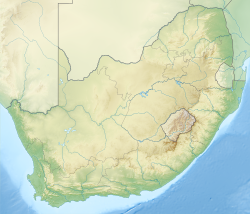| Fort Frederick | |
|---|---|
| Port Elizabeth, South Africa | |
 The fort situated along Athol Fugard Terrace | |
| Site information | |
| Type | Mortared construction |
| Controlled by | |
| Open to the public | Yes |
| Condition | Intact |
| Location | |
 | |
| Coordinates | 33°58′00″S25°37′17″E / 33.966588°S 25.621436°E |
| Height | 2 floors, wooden blockhouse burned down |
| Site history | |
| Built | 1799 |
| Materials | Local stone and wood |
| Events | Napoleonic Wars, Invasion of the Cape Colony (1795), British rule in South Africa, 1820 Settlers |
| Garrison information | |
| Past commanders | Captain Francis Evatt (1817–1847) |
| Occupants | British Forces |
Fort Frederick in Port Elizabeth, South Africa, was built in 1799 in order to stop the French from conquering the Cape Colony during the Napoleonic Wars and played a vital role in establishing British rule in South Africa in combination with the Battle of Blaauwberg. The fort has never fired a shot from its guns.





